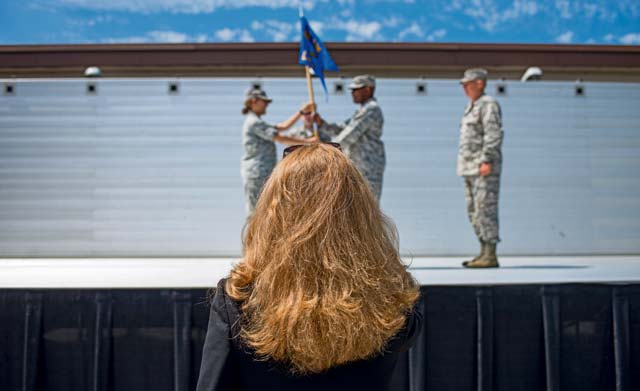
There hangs a simple white board, covered in what seems are the trivial scribbles of a to-do list. Though insignificant at first glance, a closer look reveals extraordinary events like meeting President Obama and the Air Force chief of staff, to planning the details of a change of command and promotion ceremonies.
With the responsibility of providing support to approximately 22,000 military members and Department of Defense civilians within the 86th Airlift Wing and 435th Air Ground Operations Wing, the four-man 86th AW protocol office also helps their neighboring protocol friends from the 521st Air Mobility Operations Wing, U.S. Air Forces in Europe and NATO.
“I was overwhelmed when I first got here three months ago,” said Teresa Bracher, 86th AW chief of protocol. “I thought I knew what Ramstein did, but I didn’t understand truly how busy it was. For example, in just May, June and July, we had to perform 60 changes of command as well as dry runs. That’s not including the retirements, promotions, congressional visits, support for the president and the vice president.”
Due to Ramstein’s location and diverse mission, protocol Airmen must stand ready to schedule, organize and execute an average of 500 distinguished visitor tours and visits to Ramstein every year.
“We have someone on call at all times just in case we have an unexpected arrival,” Bracher said. “We have to stay flexible and adapt to anything that happens; like when General Welsh came here we only had about a week to make everything happen, but our dedicated team and project officers made it a success.”
Project officers act as a point of contact to start the process of retirements, promotions, changes of command and much more within their respective units. Though trained to handle the kickoff and main body of the various ceremonies, project officers work hand-in-hand with protocol for their keen eye, expertise and extensive knowledge.
“The project officer’s job is to do the leg work for their event,” said Tech. Sgt. Raul Rodriguez, 86th AW protocol member. “They let us know what type of event they are in charge of, and then we work together on the itinerary to ensure every possible variable has been taken care of.
“There will be times when a project officer comes to us with only a few days to prepare a DV visit or ceremony and we have to shove about a month’s worth of knowledge in their head,” Rodriguez continued.
Originally a maintainer, Rodriguez was searching for new ways to challenge himself; he felt the best way to do that was to trade his wrench for teaspoons.
“I always look for new ways to challenge myself, and nothing is so far out of my original spectrum of work like protocol,” Rodriguez said. “When I worked on the flightline, I only saw what I was doing right then and there. But being able to see the other side of how the Air Force functions, now allows me to see the big picture.”
Tasked with a multitude of events throughout the year, the protocol Airmen continue to grow not only their skill sets and knowledge but ability to work as a team, allowing them to complete the numerous events on their not-so-trivial whiteboard.
“We really do have the sharpest of the sharp,” Bracher said. “The Airmen on this staff, no matter their background, will adapt to the challenges ahead of them. There is no room for failure when we need people that can present themselves appropriately, know computer skills, are capable of directing high-level foreign and domestic officials, and much more.
“The best thing about being a part of this office is when I come in and I hear everybody laughing,” Bracher continued. “In through the midst of all the hard work, pressure and stress of getting the job done they are still able to have fun and enjoy themselves. You really get a sense that they love what they do, and it shows every day in the products they deliver to Ramstein.”


